ChatFlash
📝 neuroflash sees itself as a constantly evolving tool. We recently introduced the ChatFlash feature, which makes it even easier to get in touch with our magic pen—similar to a chat.
Where can I find the chat? You can find the chat in the AI copywriter.
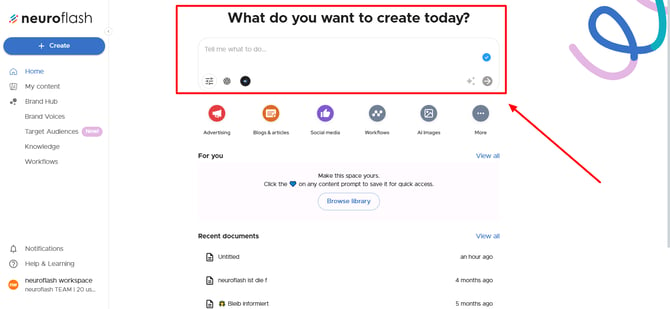
Simply enter your request, question, or instruction there and press Enter to complete your entry. To add a new line, press Shift+Enter.
Can I also access the chat in the current document?
You can also use our chat feature in the current document. There is a button in the right-hand toolbar that takes you to the chat.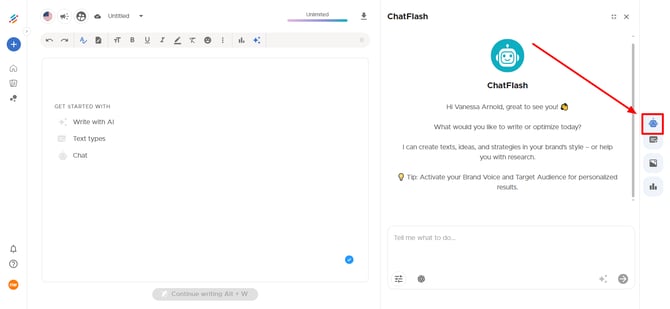
Is there a chat history?
Our chat saves your inputs and outputs. However, you can also reset the chat manually at any time.
Which languages does the chat support?
You can chat in any language. Just start the chat in the language you want to use.
If my document is in one language, can the chat be in another language?
It is not possible to customize the chat language separately in a document that has already been created. However, the magic pen will usually respond to you in the language you use to address it.
What features does ChatFlash have?
ChatFlash has the following main features:
1. Choice between different AI models
ChatFlash allows you to choose between different AI models. Depending on your pricing plan, you can choose between models such as GPT, Gemini, Claude, and Mistral.
| GPT-5 | GPT-4.1 mini | GPT-4.1 | Claude Sonnet 4 | Claude Opus 4 | Gemini Flash 2.5 | Gemini Pro 2.5 | Mistral Small 3.1 | Mistral Medium 3.1 |
| Pro |
Free |
Pro | Pro | Business | Free | Pro | Free | Free |
Before you start chatting, simply select the model you want to use and start chatting. You can change the model at any time during the chat without resetting the chat.
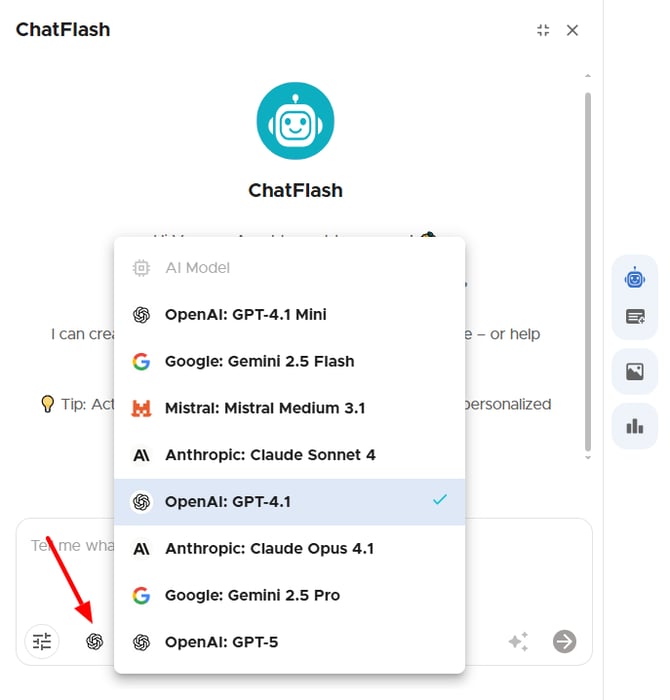
Different models lead to different results:
GPT-5
Strengths:
-
Best brand voice adaptation (tone, structure, style rules)
-
Writes clearly, factually, and on-brand
-
Perfectly combines information and personality
-
Maintains consistent style even in long texts
Weaknesses:
-
Slightly too polished, somewhat distant in spontaneous topics
Ideal for:
→ Brand communication, articles, trend analyses, qualitative insights, content workflows
Gemini 2.5 Flash
Strengths:
-
Fastest model – excellent for research and data gathering
-
Precise, analytical, and factual
-
Very efficient for structured topics
Weaknesses:
-
Little narrative depth
-
Style can feel flat or overproduced
-
Weak emotional tone or personality
Ideal for:
→ Quick web research, data foundations, FAQ texts, information updates
Gemini 2.5 Pro
Strengths:
-
Analytical, journalistic, and well-structured
-
Good balance between emotion and precision
-
Great for reports and executive summaries
Weaknesses:
-
Distant, lacks spontaneity
-
Feels curated rather than conversational
Ideal for:
→ Management reports, whitepapers, structured articles
Claude Opus 4.1
Strengths:
-
Linguistically strong, emotional, and creative
-
Very human in expression
-
Excellent “voice clone” of real people
Weaknesses:
-
Overly dramatic, inconsistent style
-
Less factual depth, slightly editorial in tone
Ideal for:
→ Storytelling, empathetic writing, qualitative research (verbatims, quotes)
Claude Sonnet 4
Strengths:
-
Emotionally relatable and human
-
Good everyday tone
Weaknesses:
-
Unstable style, occasional editorial artifacts
-
Inconsistent tone
Ideal for:
→ Audience simulations, emotional test texts
GPT-4.1
Strengths:
-
Solid, reliable, and fact-oriented
-
Clean grammar and clear structure
Weaknesses:
-
Simple, uninspired, lacking dynamism
Ideal for:
→ Standard texts, neutral content production
GPT-4.1 mini
Strengths:
-
Compact, clear, and brand-consistent
-
High tonal stability despite smaller capacity
-
Performs well on longer texts
Weaknesses:
-
Low emotional depth, somewhat distant tone
Ideal for:
→ Scalable text production (snippets, FAQs, microcopy)
Mistral Medium 3.1
Strengths:
-
Calm, precise, and professional
-
Technically solid with clear structure
Weaknesses:
-
Unremarkable, slightly sterile
-
Limited emotional depth
Ideal for:
→ Technical or factual content
2. Web Search
Web search in ChatFlash means that you can connect the AI directly to the internet in the chat—so you don't get fixed knowledge from training data, but rather up-to-date information live from the web. Select online search and start the chat:
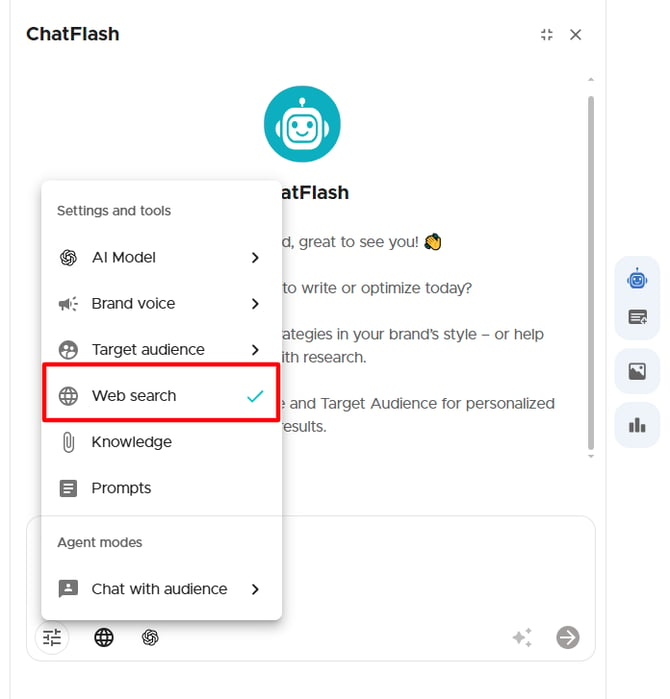
Web search in ChatFlash means that you can connect the AI directly to the internet in the chat—so you don't get fixed knowledge from training data, but rather up-to-date information live from the web. Select online search and start the chat:
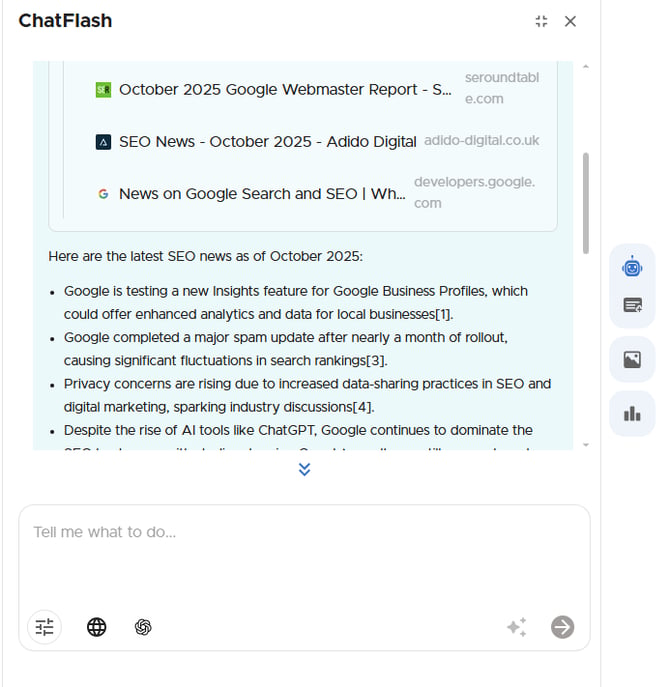
❗ Important: Web search is not automatically performed for every query, even if you have enabled the feature. However, it can also be triggered by your prompt if the AI model recognizes that a web search is useful or necessary for your query.
The best model for web searches is Gemini 2.5 Flash. It conducts research the fastest and most accurately, clearly separates facts from interpretation, and provides structured, factual summaries. Ideal if you need up-to-date information, trends, or data and value efficiency and factual quality.
3. Using Knowledge in the chat
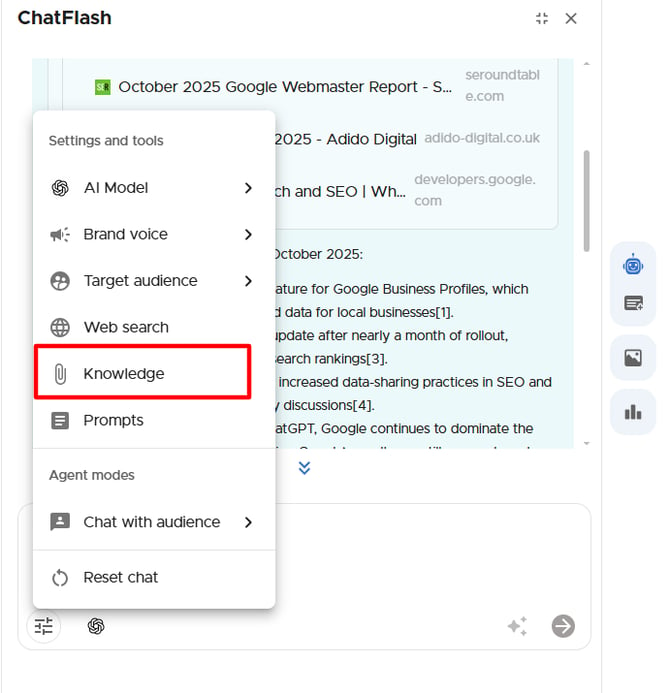
The knowledge function in neuroflash allows you to integrate your own knowledge into the AI chat. You can upload documents, crawl websites, or copy and paste text to create a knowledge document.
👉 Here you can learn how to create a target group in neuroflash.
ChatFlash can then actively use this knowledge in conversations—for example, to answer questions, write texts in the brand style, or create content based on internal information.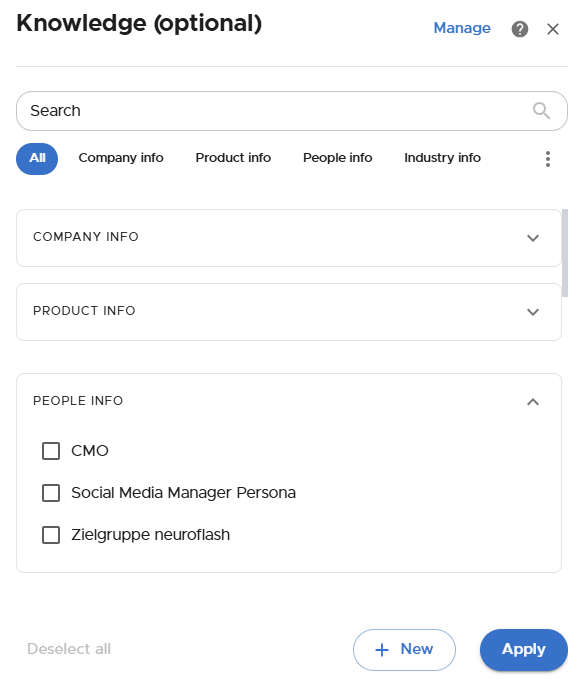
4. Using Brand Voice and Audiences in chat
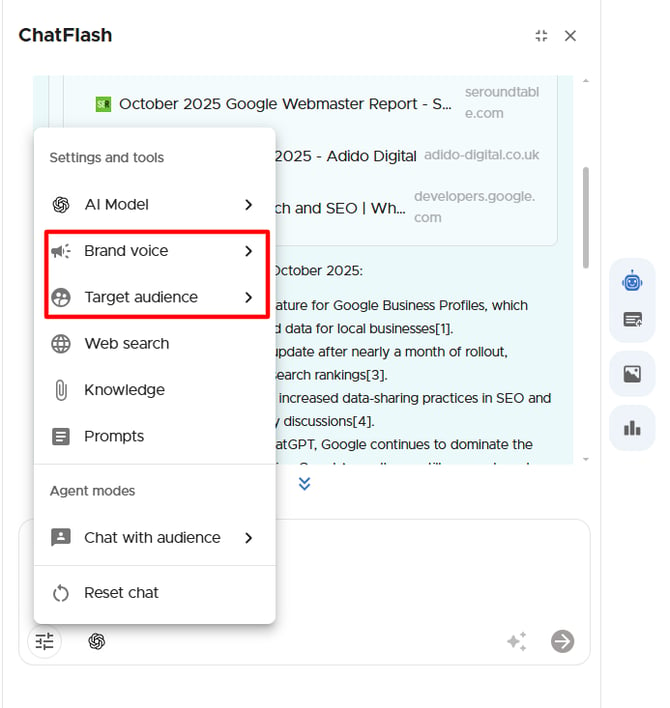
A brand voice is the consistent brand voice that determines how your brand sounds and communicates—i.e., the tone, choice of words, and attitude it uses in all texts. You create the brand voice in neuroflash—either by extracting it from existing texts or by manually defining the tone, words, and style rules.
👉 Here you can learn how to create a brand voice in neuroflash.
In neuroflash, a target group is an AI-based profile based on real psychographic and demographic data. Each target group represents a specific group of people – e.g., “marketing manager in a medium-sized company” or “Gen Z consumer with a focus on sustainability” – with clearly defined values, motives, communication styles, and decision-making behavior.
👉 Here you can learn how to create a target group in neuroflash.
In ChatFlash, you can use your brand voice directly to ensure that all responses are formulated in the tone, style, and according to the rules of your brand. In addition, you can activate a target group, i.e., a data-based profile with real values, motives, and communication styles. This creates relevant, brand-loyal content in the chat that sounds exactly like your brand speaks – and exactly like your target group thinks.
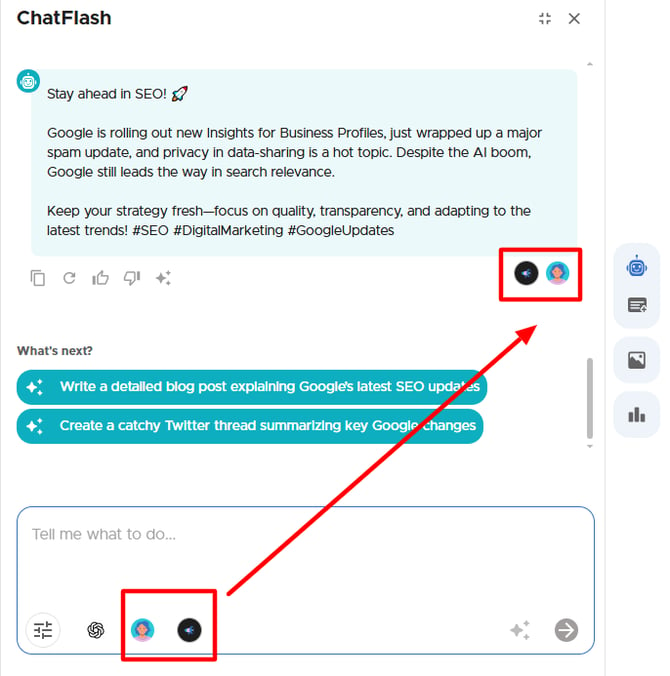
The best model for brand voice is GPT-5. It understands tonality, style rules, and brand logic like no other model and keeps them consistent even across long texts. GPT-5 writes in a brand-consistent, structured, and human way, making content sound as if it were written by a real brand writer.
5. Chat with Target Audience
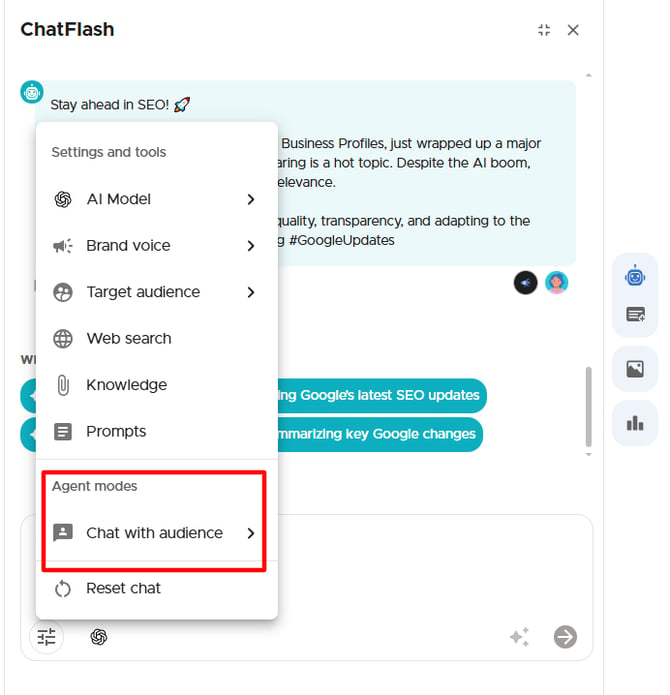
The “Chat with your target audience” feature in ChatFlash allows you to have realistic conversations with simulated target audience profiles—e.g., a typical marketing manager, an agency manager, or a Gen Z customer. This allows you to directly test feedback, objections, or reactions to texts, claims, or campaigns without having to conduct real surveys.
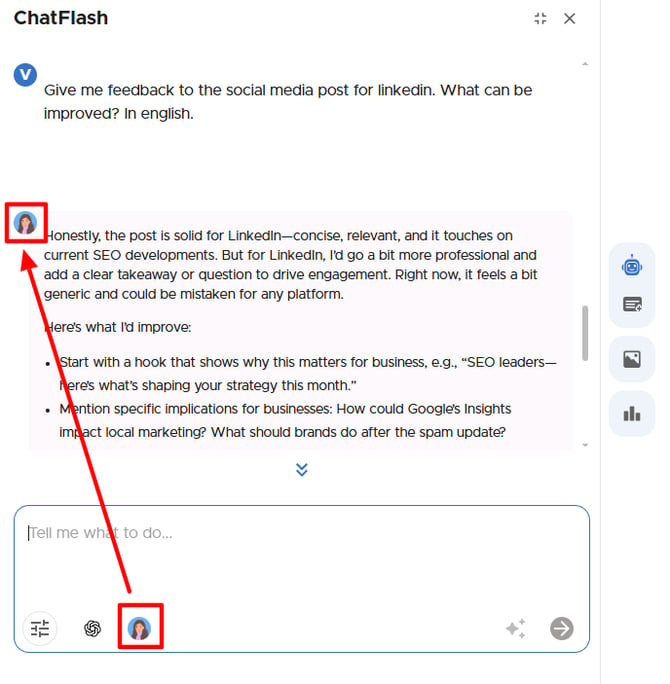
Claude Opus 4.1 is best suited for this because it responds in the most human, emotional, and spontaneous way. If you need more structure or brand relevance, GPT-5 is the best choice—it simulates credible target group voices while remaining more analytical and brand-compliant.
6. Prompt-Library & Optimizer
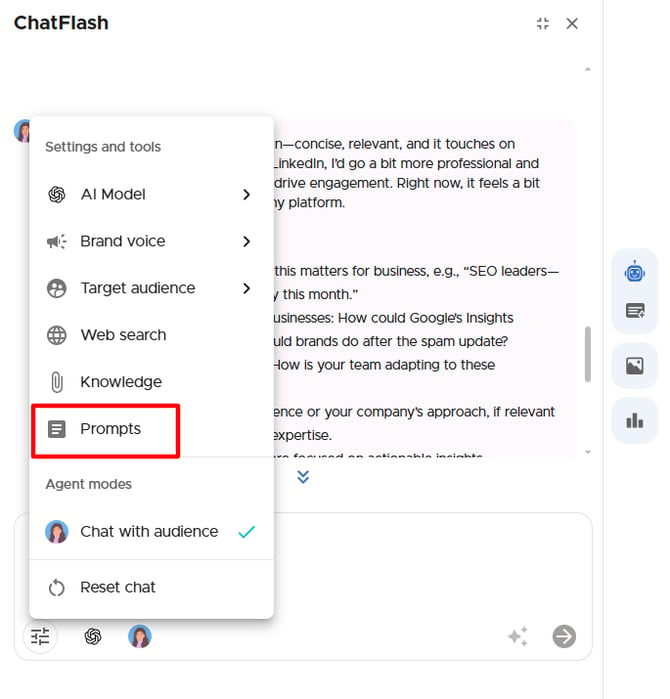
You can use Chat. There you will find ready-made or fillable prompts for various use cases—from blog articles to emails to social posts—that are already optimized for optimal results. You can also create your own prompts and share them publicly so that other users can benefit from them. This saves you time and eliminates the need to come up with complex prompts yourself.
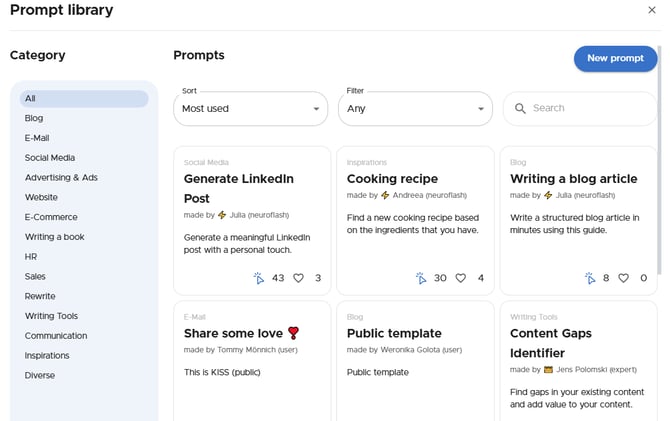
In ChatFlash, you can also have your prompts automatically improved by AI before you send them. The AI analyzes your input text and optimizes it to make it more precise, clearer, and more targeted—for example, by improving the wording or adding missing context. This means you get better results with just one click, without having to know how to write perfect prompts yourself.
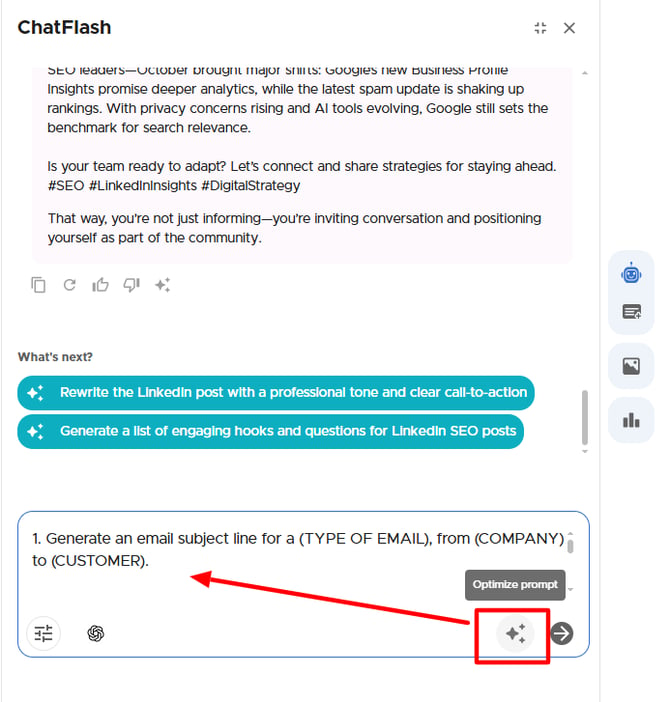
Top tips for using ChatFlash
-
Choose the right AI model for your task:
– GPT-5 for brand-consistent, high-quality writing
– Gemini 2.5 Flash for fast and precise web research
– Claude Opus 4.1 for emotional, human-like responses -
Use your Brand Voice:
Set it up once in neuroflash – then the chat automatically writes in your brand tone and style, no matter the topic. -
Activate a target audience:
Simulate realistic conversations with your target audience to test feedback, reactions, and perspectives before publishing your content. -
Use online research:
Let ChatFlash gather up-to-date facts and trends directly from the web and cite sources transparently – perfect for blog articles, news, or reports. -
Leverage your own knowledge:
Upload documents or crawl websites to integrate your company knowledge into the chat – keeping the AI factually accurate and on-brand. -
Access the Prompt Library:
Start with ready-made or fill-in prompts instead of writing from scratch – or share your own templates with others. -
Automatically improve your prompts:
Let the AI refine your input before sending, making your instructions clearer and your results more precise.
-1.png?width=500&height=96&name=Logo%202%20Colour%20-%20No%20background%20(5)-1.png)